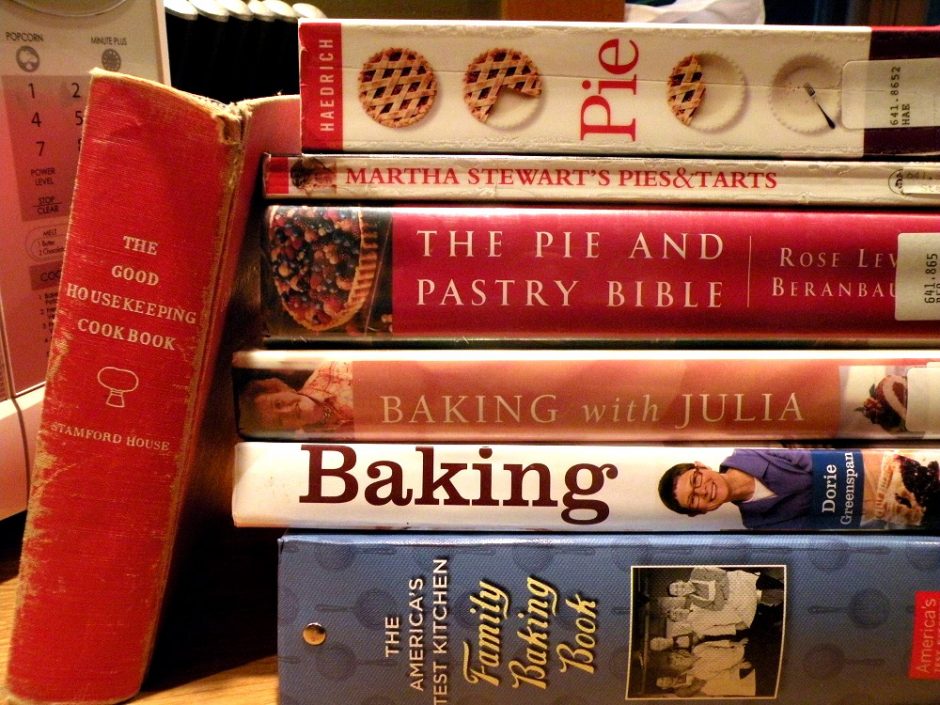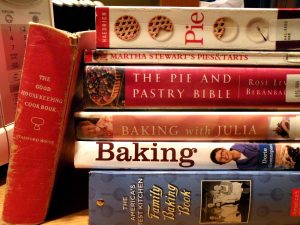
In July, I decided to up my game and start making new pie recipes once a week. Practice makes perfect is what I hear. And most people will say that it takes years of practice to become a master pie maker. So, I’m going to condense years of practice into an intensive fall/winter pie school and come out next spring with a strawberry rhubarb pie that will knock your socks off!
Like any good student, I’ve started studying everything I can get my hands on about pie. Blogs, websites, books, articles… you name it, I’ve probably uncovered it.

From Julia to Dorie to a 1940’s Good Housekeeping cookbook, I’m trying to learn the basics as well as take note of any interesting techniques or tips. For instance, the Good Housekeeping cookbook is the only one that had a great tip for how to not over mix the crust – push the dough that is ready to the side of the bowl with a fork while you continue to sprinkle water on the dry parts. That way you don’t end up with too much water in your dough.
Here is what I have learned so far about gear (I’m still reading!)
Get the right tools
Like any good baker, you need to have the proper tools to make good pie. It seems that the top two methods for mixing crust are a pastry blender and a food processor. You also need to invest in a good rolling pin (I have yet to spring for the $30 that this costs). Here’s a link to a good article about pie gear:
http://www.goodhousekeeping.com/product-testing-old/reviews-tests-old/kitchen-cooking-old/pie-making-tools-pastry-blenders
I purchased the OXO pastry blender mentioned in this article at Sur La Table. I dragged my family to 6 stores before I finally found one at Sur La Table!!! Don’t pay more than $12 for one – there are some out there for $20, but that’s not necessary.
You will also need a bowl that’s big enough to get both of your hands into. A deep but narrow bowl is a flour disaster waiting to happen.
The pan is where it’s at
Unlike the rolling pin, the most revered pie pan is the 9″ glass Pyrex pan. It’s only around $7 if that! A 9″ pan is the most basic pie size and will accommodate most recipes.
If you are making a pie that has a double crust and lots of fruit, then you will want to consider a 9.5″ deep dish pan. Pyrex also sells a great set of 2. If you want the holy grail of pie pans, then spring for an Emile Henry enamel pie plate. They are beautiful and most reviews give their ability to brown a bottom crust a big thumbs up. You can get them at Williams Sonoma and Sur La Table and I’m sure other places. But, that’s easy for me to say because by sheer luck, I happen to have one that I picked up for $5 five years ago at a garage sale! Yet another sign that I was meant to make pie.
Other important supplies
Before you dive in with me, be sure to stock your kitchen with the following:
Parchment paper – Because after I master the crust of a whole pie, the “pie but not pie” recipes is where it’s at. Handpies, pie on a stick, mini pies, pie pockets… many of which need to go on a baking sheet with parchment paper.
Wax paper – Many people suggest using wax paper to roll out dough. I’m not completely sold on this (it slips all around on my counter!), but get some just in case.
Pastry brush – Get two of them. Regardless of what shape the pie takes on, they will be brushed with milk or an egg wash and a brush will ensure that you don’t over-moisten the dough.
Next up… tricks of the trade 102!
Emily, have you tried rolling the dough out on plastic wrap?
I put my hand under water, spread my hand around on the clean counter top to make it a little wet, then lay a large piece of plastic wrap on the wet counter.
The water makes it stick to the counter, and cleanup is a breeze!